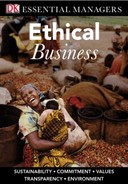Selling Ethically
Marketing is the process of creating, distributing, promoting, and pricing products. Fraud can become a problem when marketing communications, such as advertising, are false or misleading. This is a serious issue because, even if committed accidentally, it can destroy customers’ trust in a company—trust that the company may never be able to regain.
Avoiding fraudulent advertising
Deceptive sales practices include providing inaccurate information about your product or misinformation about a competitor’s product, so it is very important to be sure of your facts before you devise your marketing strategy. What makes an advertisement fraudulent—or capable of being proved so in court—is not always crystal clear. There is a widespread, difficult-to-define problem called puffery, which involves exaggerations of the truth that no reasonable buyer would find reliable or take seriously. For example, pizzerias frequently advertise that they have the “world’s best pizza.” This claim has been made so many times, and can in no way be proven because of its subjectivity, that a reasonable person would not believe it. Puffery also includes the use of words such as “natural” to imply that a food is healthy when its health benefits are, in fact, dubious.

Knowing the types
There are two main types of advertising fraud: implied falsity and literally false advertising. Implied falsity is when an advertisement confuses or deceives the consumer. Advertising using implied falsity makes claims that are literally true, but are nevertheless misleading. For example, a company was accused of deceit after advertising that a line from sweaters was made partially from cashmere. The material was in fact made from recycled cashmere instead of virgin cashmere. The company admitted that its label was deceiving because it implied that the cashmere was virgin, but, since it was technically still cashmere, the company maintained that it was guilty only of implied falsity. An implicitly false claim, while true at face value, needs qualification to prevent it from being misleading to consumers. Literally false advertisements can be divided into two subcategories:
If one company markets an item as being “better” than another company’s, it could be engaging in a nonestablishment claim. It would be near impossible to prove one item’s superiority over another’s because people have different ideas of what constitutes real “superiority.”
It is often difficult to distinguish implied falsity from advertising that is literally false.
Establishment claims: advertisements that falsely cite a study to prove their claims
Nonestablishment claims: advertisements that make claims that cannot be proven.
Consumer fraud
Organizations need to be aware of, and on the lookout for, consumer fraud, when a consumer tries to deceive a business for personal gain. This dishonest behavior can be very costly to an organization, and comes in various guises:
Dishonest customers typically know the difference between right and wrong, but intentionally use tricks to cheat an organization.
Shoplifting
Switching price tags for ones from cheaper items
Lying about age to get an age-related discount
Collusion—when an employee assists the consumer in committing fraud, such as by giving large discounts to their friends
Taking back used clothing to get a full discount
Conspiring with the cashier to get an unwarranted discount.
